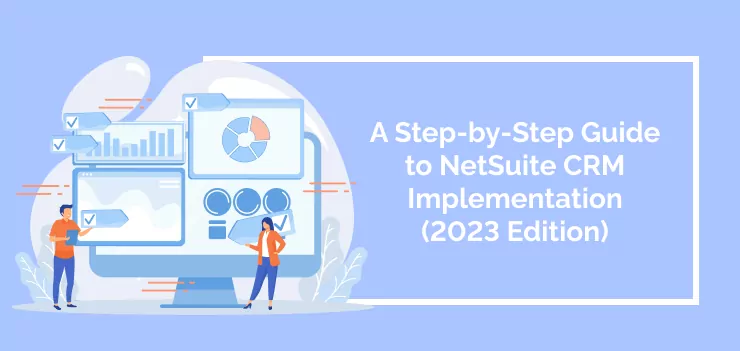
With its capability to improve service delivery, enhance operational processes, and ultimately improve the bottom line, a modern CRM (Customer Relationship Management) system emerges as an essential tool for businesses wanting to strengthen their customer relationships.
NetSuite’s Customer Relationship Management (CRM) software stands out as the premier cloud-based solution, providing businesses with comprehensive 360-degree capabilities to seamlessly manage their prospects, clients, partners, and vendors in one centralized location.
According to Statista, the software as a service (SaaS) market is estimated to be worth around 197 billion U.S. dollars by 2023 and will reach 232 billion U.S. dollars by 2024.
In 2019, spending on Software as a Service (SaaS) reached approximately $42 billion, as predicted by Gartner. This type of software accounted for 75% of the total expenditure on customer relationship management (CRM) software.
As more businesses move away from on-premises deployments, the trend towards Software as a Service (SaaS) necessitates wider organizational development and change management efforts.
As such, CRM software emerges as one of the most critical components in the SaaS market, highlighting the growing demand for comprehensive and flexible solutions that can support companies through periods of change.
NetSuite CRM provides a comprehensive suite of tools and features for enterprises to effectively streamline their operations while remaining highly mutable to meet their unique customer requirements. Some of the most prominent benefits of NetSuite CRM include:
- Enhanced partner relationship management and collaboration with better visibility into the sales pipeline, marketing, forecasting, and sales analytics.
- Communication tools and features to start and maintain meaningful conversations at scale with prospects.
- Integration with existing SalesTech stacks and custom application development improves accuracy and insights.
- Superior customer service delivery by optimizing customer engagement, meeting customer preferences, and gaining a comprehensive view of customer data.
- Customizable CRM workflows that streamline repetitive tasks reduce workload and increase productivity.
- Centralized management of quotes, commissions, partner marketing, and sales forecasts, eliminating information silos and enabling strategic analysis.
This article examines NetSuite CRM implementation, providing a step-by-step guide to help sales and marketing teams navigate the process. We’ll explore implementation options and costs, delve into timelines and common issues, and discuss the benefits and challenges of implementing NetSuite CRM. Finally, we’ll provide ten critical steps for success during the NetSuite implementation process.
Understanding the Various NetSuite CRM Implementation Methods
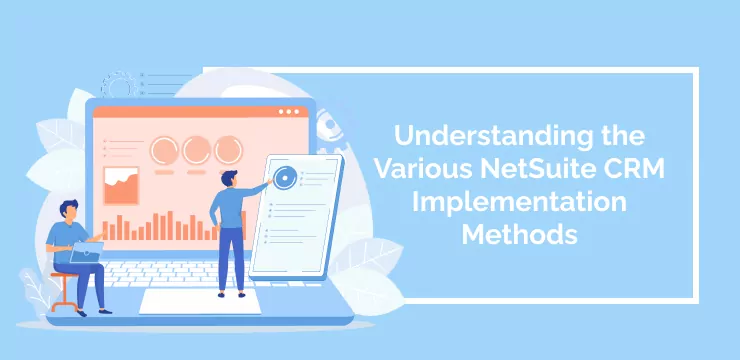
Identifying the need for enhanced customer relationships and deploying solutions that help enrich them are simply the first steps of successful CRM adoption.
Most companies will find their unique business requirements and specific use cases clash with a one-size-fits-all approach to implementation.
Once a NetSuite license has been obtained, businesses must determine the most effective approach to implementing their CRM solution. The chosen method must align with the company’s business objectives and technological capabilities.
To aid in this decision-making process, we have outlined the three primary types of NetSuite CRM implementation below:
In-house implementation
In-house implementation involves a company utilizing its internal IT department leaders to carry out the implementation process for its CRM solution. This approach gives businesses more control over the entire process, allowing them to customize the CRM to meet their needs. It is ideal for companies with an established IT department with the necessary expertise and resources to deploy the NetSuite instance and handle the implementation process without additional costs.
However, small or mid-sized businesses lacking the required technical skills or expertise may need help with this approach.
Enlisting the services of implementation experts can be expensive, as most developers with proficiency in NetSuite CRM possess a broad range of experience and knowledge from either a Computer Science, Business, or Management Bachelor’s degree.
This allows them to analyze problems, undertake complex assignments, and deliver effective solutions. While partnering with a trusted third-party provider is typically the more cost-effective option, companies with highly dynamic processes that span several verticals may require a more personalized implementation approach.
NetSuite Unmediated Implementation
Opting for a more direct implementation through NetSuite entails deploying and configuring your CRM solution directly with NetSuite’s internal implementation team.
However, NetSuite’s technical team may need help providing the customization and flexibility that some businesses need to achieve optimal results.
While NetSuite’s unmediated implementation offers several benefits, including direct access to NetSuite’s experienced implementation consultants, this approach may not be the most suitable option if your company has unique use cases, requires custom applications, or integration with other systems.
Third-party partner implementation
Third-party partner implementation is a CRM implementation method that involves partnering with a third-party vendor to deploy and configure the CRM solution.
This approach offers several benefits, including access to experienced consultants who can provide guidance and expertise. Additionally, relying on a third-party vendor offers specialized knowledge and a range of pricing tiers based on the level of customization required. Assessing the vendor’s reputation and experience in successful implementations is important.
For businesses looking for an alternative to internal or direct implementation with a software provider, third-party partner implementation offers a viable option.
NetSuite CRM Implementation Costs: What to Expect?
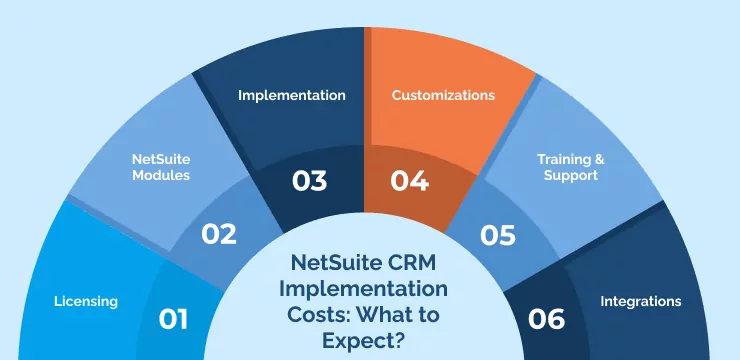
Oracle NetSuite charges an annual license fee with three main components: the core platform, optional modules, and the number of users. The initial implementation cost for NetSuite can range between $10,000 for small to medium-sized enterprises (SMEs) and over $100,000 for large, multi-pronged enterprises.
The NetSuite CRM is integrated within the wider NetSuite platform, and individual user licenses are a prerequisite for using the platform.
It’s worth noting that a partner manages the majority of NetSuite implementations. As a result, services are generally charged at an hourly rate, which can account for a significant portion of the overall implementation cost. Typically, partners charge between $170 to $250 per hour for their services.
- Licensing: The cost varies and is charged annually.
- NetSuite Modules: The cost varies and is charged annually.
- Implementation: This is a one-time fee that ranges from $10,000 to over $100,000, depending on the scale of the enterprise.
- Customizations: Fees for customizations range from $150 to $225 per hour, with charges applied based on usage.
- Training & Support: An optional one-time fee for training and support ranges between $2,000 to $15,000, depending on the user’s needs.
- Integrations: Annual integration fees are applied, with additional charges for one-time implementation fees varying from $0 to $4,000.
How Long Does it Take to Implement NetSuite CRM?
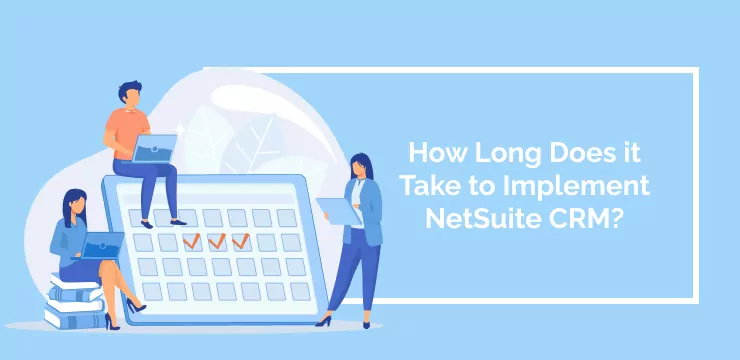
The implementation timeline of a NetSuite build can vary depending on several factors. On average, it can take anywhere from three months to over a year to complete. However, specific variables can affect this timeline, which businesses must consider when planning their NetSuite implementation.
One factor that can impact the timeline is the complexity of the business processes that the CRM solution must support. More complex processes may require extensive customization and configuration, which can increase the implementation time.
Additionally, the size of the business and the number of users utilizing the CRM solution can also influence the timeline. A larger organization with more users may require more time for training and testing to ensure a smooth transition to the new system.
When done right, CRM pays back $8.71 for every dollar spent, according to Nucleus Research.
Another factor to consider when estimating the implementation timeline is the level of integration needed with other software solutions. The more integration required, the longer the implementation may take, as it involves aligning different systems to work seamlessly.
It’s also important to account for potential setbacks or challenges during implementation. This could include unexpected technical issues, data migration complexities, or lack of user adoption. Planning for these challenges and having a contingency plan can help mitigate their impact on the project timeline.
NetSuite CRM Implementation Benefits
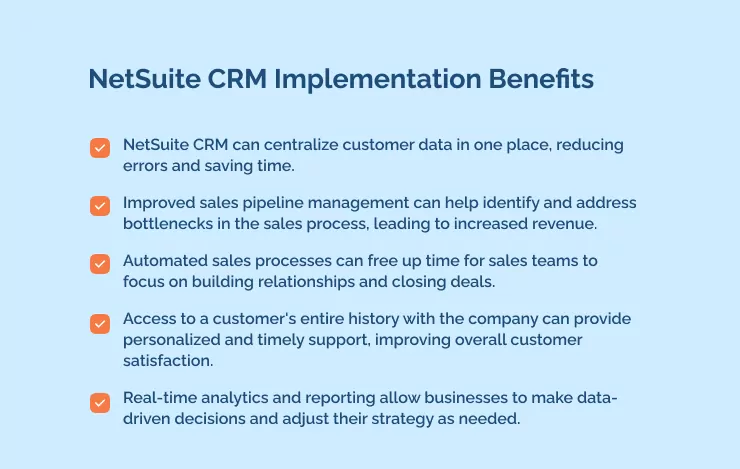
After undergoing proper implementation, the potential return on investment (ROI) of a CRM software system can surpass 245%, according to IBM.
NetSuite CRM boasts the most comprehensive CRM solution on the market, with particular success in its ability to cater to the requirements of Sales Development Representatives (SDRs) in large enterprise environments.
Whether managing sales pipelines or tracking leads, NetSuite CRM provides a comprehensive set of tools to help SDRs work more efficiently and effectively.
Here are some of the benefits that NetSuite CRM can offer businesses:
- NetSuite CRM can centralize customer data in one place, reducing errors and saving time.
- Improved sales pipeline management can help identify and address bottlenecks in the sales process, leading to increased revenue.
- Automated sales processes can free up time for sales teams to focus on building relationships and closing deals.
- Access to a customer’s entire history with the company can provide personalized and timely support, improving overall customer satisfaction.
- Real-time analytics and reporting allow businesses to make data-driven decisions and adjust their strategy as needed.
SuperOffice’s research highlights that CRM software is the largest global software market, with no signs of slowing down. The market is predicted to generate $80 billion in revenues by 2025.
NetSuite CRM Implementation challenges
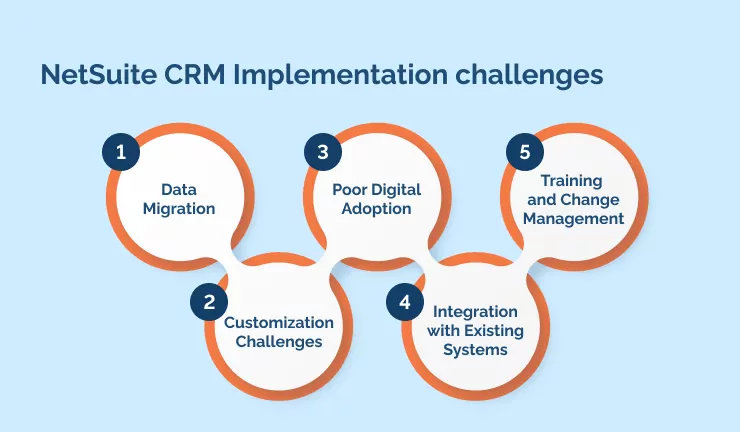
Deploying a NetSuite CRM build can be complex, requiring careful consideration to avoid potential data loss, budgetary issues, or delays. By proactively identifying and addressing these challenges, businesses can implement effective measures to guide NetSuite deployment.
Below are a few challenges that businesses may encounter when implementing a NetSuite CRM build:
- Data Migration: Moving data from legacy systems to NetSuite can be time-consuming and complex, with data loss or corruption risks. Careful planning and execution are crucial to ensure a successful migration.
- Customization Challenges: Customizing NetSuite to suit specific business objectives can be challenging, particularly for organizations with little experience in software development. Without adequate planning, customizations can lead to delays and budget overruns.
- Poor Digital Adoption: Challenges around digital adoption can arise when implementing a NetSuite CRM build. This often occurs when employees resist change or need more skills or training to use the system effectively. Poor adoption can lead to incomplete or inaccurate data entry, negatively impacting customer relationships and sales. A 2022 Salesforce study found that 66% of sales representatives feel inundated by the number of tools they use, and yet sales teams require an average of ten tools to close a deal successfully.
- Integration with Existing Systems: Integrating NetSuite with existing systems can be a major challenge, especially if multiple systems need to communicate. Ensuring smooth communication between systems is critical to maintaining business continuity.
- Training and Change Management: Proper training and change management is essential to ensure user adoption and maximize the benefits of NetSuite. Failure to address these areas can lead to resistance and frustration among employees, which can negatively impact the project’s success.
NetSuite Implementation Process: 10 Steps For Success

- Identify pain points and set goals.
Identifying pain points and setting goals is a critical first step toward a successful NetSuite CRM implementation. Pain points are the areas in your current processes that create challenges and inefficiencies for your team. Identifying these pain points allows you to assess how NetSuite can address those challenges and streamline your business processes.
It is essential to involve key stakeholders to understand their prerogative. This insight will help you set realistic goals for the implementation project, such as improving data accuracy, reducing manual processes, increasing productivity, and enhancing customer satisfaction.
Setting specific objectives, such as increasing sales by 20% or reducing response time by half, will help you measure the success of the implementation project. Establish clear, achievable, measurable goals aligning with your business strategy and vision.
Documenting your pain points and goals in a formal project plan will help keep the project on track and ensure everyone is on the same page. Regularly revisit and update the project plan to reflect priorities, timelines, and budget changes.
- Building your implementation team
The success of a NetSuite CRM implementation project heavily relies on building a strong implementation team. The team should consist of professionals possessing diverse skill sets and expertise, such as business analysts, project managers, developers, and subject matter experts.
Forming a team with experience in implementing CRM systems, knowledge of NetSuite, and familiarity with your business processes is crucial. It is also vital to determine whether you will use NetSuite developers, an in-house team, or third-party partners based on the technical capabilities within your deployment team to ensure effective implementation.
- Leverage Native Configuration
Prioritizing native configuration before custom app building is a smart approach to implementing NetSuite CRM successfully. Native configuration uses built-in features and tools to meet business needs while reducing costs and simplifying maintenance.
Start by identifying relevant NetSuite modules and features that align with business processes and goals. Configure these options based on best practices, establish data governance policies, and test the setup against objectives.
Using native configuration as a starting point, companies can significantly reduce the time and costs of building custom applications from scratch. Using NetSuite’s native capabilities provides an efficient and cost-effective way to meet immediate business needs while setting the foundation for future customization.
- Data migration
Figuring out how to migrate legacy data is crucial in the NetSuite CRM implementation process. Data migration involves transferring data from your existing system to NetSuite, which is essential for ensuring business continuity and a smooth transition to the new system.
Here are some relevant questions that companies need to ask themselves when migrating data to NetSuite:
- What data do we need to migrate from our existing system to NetSuite, and what is the best way to extract it?
- What are the data formats, quality, and volume of the data we need to migrate, and how will they affect the migration process?
- Who will manage the data migration process, and do they have the necessary skills and expertise?
- What is the data migration process timeline, and how will it impact our business operations?
- What risks and challenges are associated with data migration, such as data loss, corruption, or system downtime, and how can we mitigate them?
By asking these questions and developing a comprehensive data migration plan, companies can ensure a smooth and successful transition to NetSuite while maintaining data accuracy and integrity. Identify the data needed for business operations, develop a data migration plan, establish data governance policies, test the migration process, and perform a post-migration test to ensure a smooth and successful transition.
5. Assess change capabilities
Coordinating your transition to NetSuite CRM involves change management, a critical component of any successful implementation process.
“The times when the business has failed to change or avoided its evolution have been the times when the team has given in to complacency,” says Kara Hertzog, president of Innovative Employee Solutions, via Forbes.
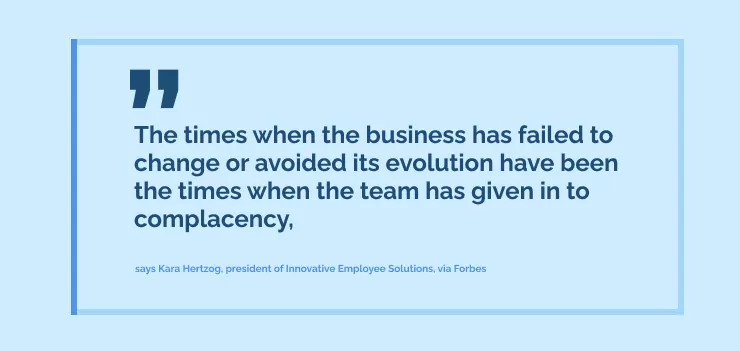
As such, it’s essential to assess the change capabilities of your organization. This entails evaluating your staff’s readiness and identifying potential challenges and resistance to change.
Organizational change can be disruptive, so it’s crucial to identify key stakeholders who can play a significant role in driving adoption and buy-in. These stakeholders may include executives, managers, team leads, and end-users. Communication and transparency are critical in this phase, and it’s essential to ensure everyone understands the reasons for the change and how it aligns with the company’s overall strategy and goals.
Implementing a new CRM system like NetSuite can impact every aspect of the organization, from sales and marketing to finance and customer support. Therefore, it’s crucial to consider all business units and how the new system will impact their operations.
- Integrating Feedback from Your Team
When implementing NetSuite, one of the most crucial steps is gathering user feedback from your team. This feedback is essential to tailor the implementation process to fit your organization’s needs and ensure its success.
Consider using questionnaires and surveys targeting specific interest areas to gather this feedback. This will allow you to identify pain points and areas of improvement that need to be addressed during the implementation process. By taking the time to gather user feedback early on, you can ensure that your team is involved in the process and invested in its success.
Below are some potential feedback questions that can be asked of teams utilizing the CRM system:
- How would you describe the current CRM system we are using? Are there any particular pain points or areas that you find particularly frustrating?
- Have you noticed any trends or patterns in customer interactions that could be addressed with changes to our current CRM system?
- What features or functionality are essential for a CRM system to support your SDR role effectively?
- Are any specific tasks or workflows you find particularly time-consuming or tedious within our current CRM system?
7. Live Deployment
Live deployment is the final step in the NetSuite implementation process, and it is the point at which your organization will begin to use the software in a live environment. This is a critical phase because it involves transitioning from testing and training to actual usage.
Before going live, it is important to conduct thorough testing and ensure all data has been migrated correctly. NetSuite recommends a parallel testing approach where the old system and NetSuite are run alongside each other for a period of time to ensure there are no issues during the transition.
The live deployment can begin once you are confident everything is working correctly. This typically involves switching off the old system and making NetSuite the primary one. It is important to note that during this transition, there may be some downtime or disruption to normal business operations. Therefore, Scheduling the go-live during a period of low activity or outside of business hours is recommended.
After the go-live, it is important to monitor the system closely to ensure everything is running smoothly. Any arising issues or problems should be addressed quickly to minimize disruption to business processes. It is also important to continue providing training and support to users to ensure they are comfortable using the new system.
8. Encourage Digital Adoption Training
One of the most critical steps in successfully implementing NetSuite CRM is to encourage digital adoption training. With proper training, users can understand and utilize the software’s full potential. Implementing a new CRM system can be daunting for any organization, but providing adequate training can alleviate some challenges.
A key solution to ensuring successful digital adoption is leveraging a digital adoption platform (DAP). A DAP provides step-by-step guidance within the software to help users navigate the system. This technology can help reduce errors and improve efficiency by streamlining processes and providing users real-time feedback and support.
One provider that offers an outstanding DAP is WalkMe. WalkMe’s customizable platform allows personalized training and onboarding experiences tailored to an organization’s needs. Their DAP helps employees learn and adopt new software programs quickly and efficiently, reducing the learning curve and enabling users to be productive from day one.
WalkMe’s DAP solutions offer a variety of features, such as contextual guidance, on-screen prompts, and real-time support, enabling users to get the help they need when they need it. The technology can be used throughout the implementation process, from data migration to customizations, integrations, and beyond.
By leveraging WalkMe’s DAP, organizations can minimize the risks associated with implementing a new CRM system while maximizing the ROI. The platform’s tracking and analytics capabilities provide insights into user behavior, enabling organizations to identify areas where additional support or training may be necessary.
9. Deploy a Support Team
Deploying a support team is a critical step in ensuring the success of your NetSuite implementation. A support team can help you identify and address issues quickly, minimize downtime and disruptions to business operations, and ensure that your team has the resources they need to use NetSuite effectively.
One option for deploying a support team is to work with the NetSuite team. The NetSuite team has extensive knowledge and expertise in the product, and they can provide ongoing support to help maintain your build. However, this option can be expensive, and getting personalized attention and support from the NetSuite team may take more work.
Another option is to build an in-house team of NetSuite developers and technicians. This can provide greater control over your system and ensure you can customize your build to meet your unique needs. However, this approach can also be expensive and time-consuming, and finding and retaining skilled NetSuite developers may be difficult.
Retaining the services of a third-party NetSuite partner for routine maintenance is often the most cost-effective option. Third-party partners can provide flexible support options that can scale up or down depending on your needs. Additionally, they can provide specialized expertise and pricing tiers without requiring you to maintain an internal team. However, it is important to carefully assess the reputation and experience of any third-party partner before retaining their services.
10. Test, Train, and Validate the System
Once the NetSuite CRM system has been implemented, it’s crucial to test, train and validate it to ensure that it functions correctly and that users can use it effectively.
Testing is essential in the implementation process, ensuring that the CRM system meets the organization’s requirements. This includes testing for functionality, usability, and scalability. Any issues discovered during the testing phase should be fixed before moving on to the next step in the implementation process.
Validation is the final step in the implementation process, where the system is tested in a real-world environment to ensure that it performs as expected. This includes testing for accuracy, reliability, and performance. The validation phase provides an opportunity to identify any additional issues that may not have been discovered during the testing phase.
To ensure a successful implementation, organizations need to follow these steps carefully. Testing, training, and validating the system help minimize the risks associated with implementing new software and ensure that users can use the system effectively. Organizations can improve CRM adoption rates and increase customer satisfaction by providing adequate training and support.
Ensuring a smooth NetSuite CRM rollout
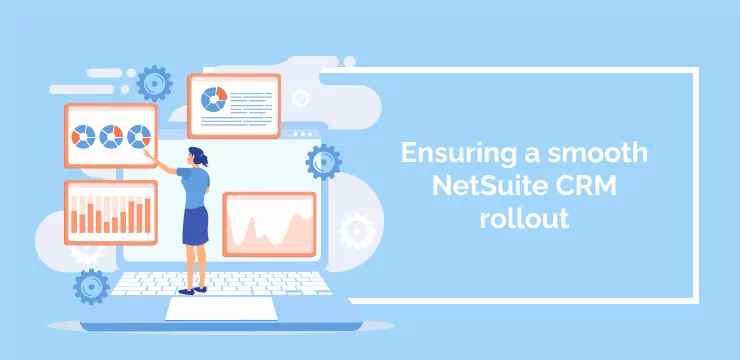
Implementing NetSuite CRM can be a complex process, but with careful planning and strategic execution, businesses can ensure a smooth rollout that maximizes returns on investment. This step-by-step guide outlines best practices for ensuring success, including stakeholder engagement, data migration strategies, training and support programs, and ongoing maintenance and optimization initiatives.
Forrester’s research found that a substantial majority of global software decision-makers – 61% – have either implemented or were in the process of executing customer service software. Additionally, 17% of decision-makers intend to adopt such software within the upcoming year, and 18% plan to integrate sales force automation technology. Impressively, 58% of software decision-makers aim to implement CRM technology into their operations.
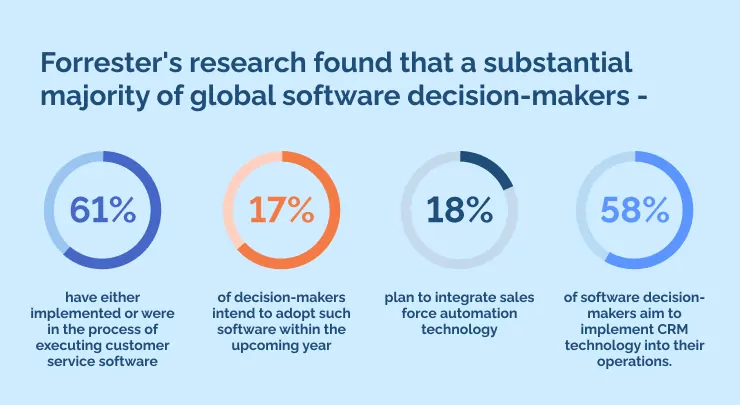
With various companies transitioning towards the cloud, the rollout of novel CRM software in the digital transformation era must be underscored with a comprehensive strategy, strong leadership, and effective communication.
Ultimately, NetSuite CRM has proven to enable organizations to achieve new productivity levels, efficiency, and growth. It’s up to business and sales leaders to seize this opportunity and leverage this powerful tool for driving business velocity.
WalkMe Team
WalkMe spearheaded the Digital Adoption Platform (DAP) for associations to use the maximum capacity of their advanced resources. Utilizing man-made consciousness, AI, and context-oriented direction, WalkMe adds a powerful UI layer to raise the computerized proficiency, everything being equal.



